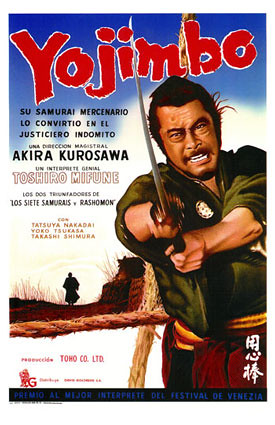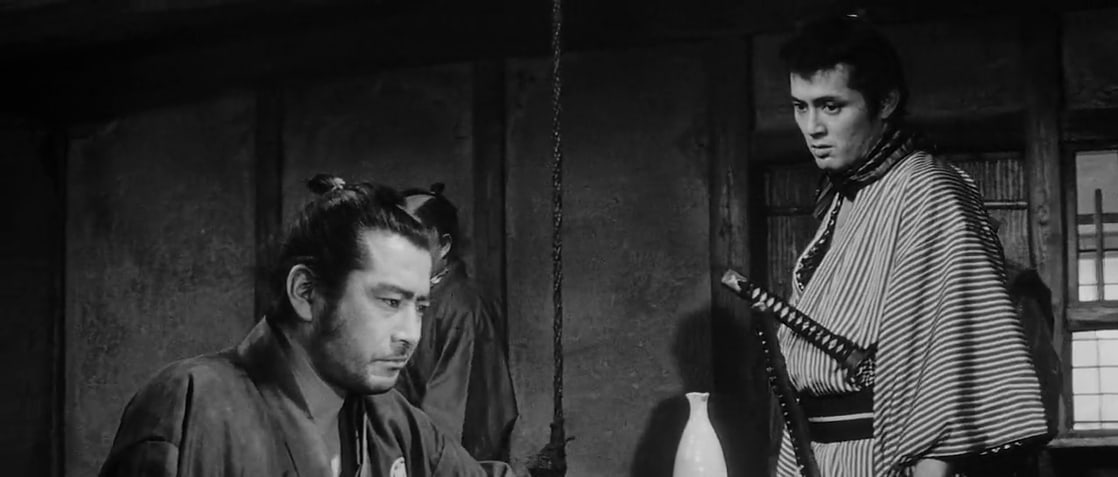
Pretending to be on Ushitora's side, Sanjuro is able to convince Ushitora that the woman was kidnapped by Seibei's men. Sanjuro tricks Ushitora into revealing the place where Nui is hidden, then kills the guards and reunites the woman with her husband and son and tells them to leave town immediately. Sanjuro learns that the woman, Nui, is the wife of a local farmer who lost her to Ushitora over a gambling debt, who then gave her away as chattel to the influential sake brewer, Tokuemon in order to gain his support. The next morning she is swapped with Seibei's son. But Seibei anticipated this so he kidnapped Ushitora's woman. However, Ushitora double crosses Seibei at the swap when his brother, Unosuke, shoots the assassins with a pistol. Ushitora then orders the kidnapping of Seibei's son who he offers in exchange for the two prisoners. An alarmed Ushitora rewards him for his help.

But he then tells Ushitora that it was Seibei's men who caught them. With this knowledge, Sanjuro captures the pair of killers and sells them to Seibei. Sanjuro soon learns it was two assassins hired by Ushitora who committed the murder to get the official to leave. But before the two sides clash, the untimely arrival of a bugyō (an Edo Period government official) forces both sides to make a bloodless retreat.Įventually the bugyō is called away because a government official was murdered in another town. Sanjuro leads his faction to attack the other but then "resigns" leaving Seibei to his fate. But Sanjuro eavesdrops on Seibei's wife who orders her son to kill him after the upcoming raid so that they will not have to pay his fee. Seibei decides that with the ronin's swordsmanship (a service acquired with a large payment in ryō) the time is right to fight Ushitora. Sanjuro (= thirtieth son) is implied to be a reference to his age, as he slyly quips: "Though I'm closer to forty, actually".

When asked his name, he sees a mulberry field and states his name is 桑畑三十郎 Kuwabatake Sanjuro (桑畑 Kuwabatake = mulberry field). He first convinces the weaker Seibei to hire him as a swordsman by effortlessly killing three of Ushitora's men. After sizing up the situation, the stranger says he intends to stay as the town would be better off with both sides dead. The mayor of town and silk merchant, Tazaemon, had long been in Seibei's pocket, and Ushitora aligned himself with the sake brewer, Tokuemon, proclaiming him the new mayor. Ushitora was the right-hand man of Seibei, but rebelled when Seibei decided to hand over the reins to his son Yoichiro, a useless youth. He tells the rōnin that the two warring clans are led by Ushitora and Seibei. The stranger heads to the town where he meets Gonji, the owner of a small izakaya who advises him to leave. While stopping at a farmhouse, he overhears an elderly couple lamenting that their only son has given up farm labouring in order to run off and join the rogues who have descended on a nearby town that has become divided by a gang war. What’s your favorite Leone or Kurosawa moment? Let us know in the comments below.In 1860, during the final years of the Tokugawa shogunate, a rōnin (masterless samurai) wanders through a desolate Japanese countryside. The men with no name in each film - Clint Eastwood and frequent Kurosawa star Toshiro Mifune - carry out the tasks they set out to in the first place, perhaps preserving a little justice along the way. In this intricate mashup, Alejandro Villarreal puts the two films side-by-side (to the tune of Ennio Morricone, naturally), and perhaps you can see why Toho, the Japanese production house, sued Leone before his film was released. In “Red Harvest” the protagonist - who comes to a small town trying to stop the corruption amongst local gangs and the law - has no name, thus inspiring the mysterious leads in both Kurosawa and Leone’s films.

READ MORE: 13 Essential Female-Lead Westernsīy the same hand, Kurosawa adapted ideas from Dashiell Hammett’s brilliant novel “ Red Harvest,” though he claims he modeled the film after “ The Glass Key,” but historians - and myself as a reader of both books - beg to differ. In that case, then perhaps Sergio Leone was ahead of his time in 1964 when he made “ A Fistful of Dollars,” the first film in the spaghetti western ‘Dollars’ trilogy, which was in fact a remake of Akira Kurosawa’s 1961 samurai epic “ Yojimbo."

From a postmodernist perspective, perhaps there is nothing left to art but the deconstruction of what’s already been created, piecing together the ideas of those you admire.


 0 kommentar(er)
0 kommentar(er)
